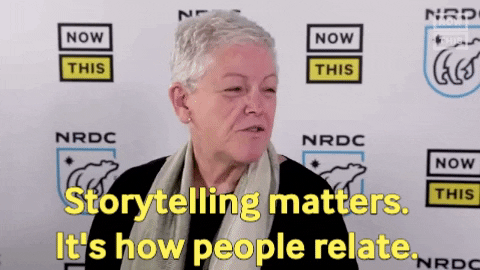Content marketing. Storytelling.
You can’t do one without the other today.
Irrespective of the industry you’re in, your target audience no longer wants to hear narcissist pitches about how good you, your products and your services are.
Gone are the times when boasting about yourself made others believe you had something valuable to offer.
Gone are the times when simply offering a BIG discount or showing a BIG list of features did the convincing for someone to make a purchase.
And definitely are gone the times when you would be the ‘only’ one offering a specific product or service. Let’s face it, the consumer today has way too many options available to them and each one has something competitive to offer.
So if you’re sticking to the age-old sales pitch, you’re either struggling to strike a chord with your audience or have hit the ceiling in terms of growth.
Now that’s where storytelling comes in.
But in this post, I’m not talking about storytelling, because:
- You’ve already read enough about it from industry experts
- If you haven’t read about it, you can read it in the blog I wrote here
So what is this blog about? Well, how NOT TO USE storytelling.
Why?
- We don’t need more sob stories
- We really don’t need another pointless web series (no offence, some of them are just beyond weird)
- We don’t need another show off (there are enough narcissists around us, I’m sure you would agree)
Storytelling status quo – We’re turning this into a sob story.
More than 63% of marketers believe that storytelling is critical to the success of their marketing campaigns.
That’s why you see more and more brands using the tactic to tap into consumer psychology, through their email marketing campaigns, content marketing efforts, social media posts, landing pages, squeeze pages, cold email marketing campaigns…you get the drift. Don’t you?
From what I’ve seen so far, working with different teams and projects, and of course, all the other campaigns I’ve signed up for here’s where storytelling is getting BORING and nothing beyond that.
1. We’re overdoing it by dragging it for too long
Storytelling’s great. Trust me when I say, the tactic helps you build a rapport with your audience and a connection that really lasts (and converts).
But storytelling does not mean beating about the bush. It means letting your audience visualize themselves using the product or service, and actually getting value out of it.
It means letting your audience see how they can use your product or service, without first having to purchase it.
But does it by any chance mean they need to keep reading stories that don’t relate it – for days or maybe even weeks at a stretch?
NO.
Come on. None of us likes an overly cluttered inbox. And most of us do not like people beating about the bush.

2. We’re trying to push stories that no one relates to
We start with creating customer personas that include information about their challenges. Then we bring storytelling in to make their challenges feel common, obvious and important to pay attention to.
We start strong. But now we’ve started to lose track because of the endless possibilities that storytelling brings us and get carried away.
Excuse the GIF. But this conveys my feelings the best…

For example, you set up a lead generation campaign for your product’s beta launch.
You are targeting 5 customer personas for your product. So your targeting starts to get you leads across all those personas.
But now it’s time to set up two things to keep these leads engaged until your launch – content marketing and email marketing.
You start to create storylines that you want to automate because obviously, you have so much more to do as well. So now your leads are going to be fed stories one after the other – some that they relate to and others that they just can’t make sense of because their set of challenges and goals are totally different!
What happens is that you start to see them fall out. You start to see them unsubscribe. You start to get responses from them that your stories are becoming all too overwhelming and when are you really going to get to the point.
Can you really blame them?
3. We’re turning things into a sob story or asking for pity all too many times
Think about the number of brands you’ve seen online that are talking about how difficult it has been for them to startup.
How difficult it has been for them to reach customers. How difficult it has been for them to sustain in a competitive market. How difficult it is for them to continue without your support. You get the drift.
While we all start by initially feeling for the brand, we’ve all come down to thinking about how many of these stories are actually true.
Admit it.
The last time you heard someone talk about the struggles, you started to wonder a couple of things:
- How long are they going to use the same story even as their brand does well?
- How true are the struggles they’re talking about?
- How long will they use garnering pity when their product sells on their own?
I’m not saying all these stories are untrue. I’m also not saying all these stories don’t need to be told.
But once you have spilt your heart out, let the story simmer. Don’t push it for too long. Don’t push your audience to start feeling like there’s no other reason to buy from you.

I spoke to a prospect very recently and unlike other brands I talk to, about marketing, here’s what he said…
“We’re doing a lot to help farmers out. But we don’t want to use the sob story to sell. What we want to use is how their hard work is delivering high-quality produce. I want to focus on the quality we’re together working towards, and attract customers with that. An about us page should do to tell them how we’re functioning.”
For the first time, in a very long time, I felt like at least someone wants to push ‘quality’ for marketing.
4. We’re getting narcissist about storytelling too
And then comes the bummer.
We’re getting the core of storytelling wrong. It has always been about making your customer the hero.
But we’ve all come down to being narcissist about it. Because while we know what storytelling is, we still don’t know how to look beyond ourselves.
We’re still assuming that our end customer thinks like us. That our needs are similar to theirs. That their choices will be similar to ours. The stories we like will be the stories they like.
I haven’t seen any worse assumptions than these.
Did these mistakes remind you of something you’ve done? Or remind you of a brand you were following on social media? Or remind you of a solopreneur or influencer who shared their story in their IGTV?
You’re not alone. I binge-watch these assumed stories all the time just to waste my time.

5. We’re changing our stories too often (or copying them)
Ever noticed how frequently individuals and brands are changing their stories?
Sometimes they feel they haven’t done a good job at it in the first go. Other times they feel someone else’s story looks better (read, competitors).
And then there are times when they feel ‘it’s not touching enough.’
So what do we do? We move away from our stories and start changing them. Week on week. Month on month. We force our own story out of the story. If you get what I mean!

Storytelling is about being authentic. Not perfect.
While I agree that you need to be strategic about using storytelling to drive conversions, I also feel that you don’t need to make it all too “scripted”.
It’s like watching Keeping up with the Kardashians for your audience then.
So when they don’t resonate with you or your brand, can you really blame them here too?
Or your copywriter? Not really.
Storytelling has gone way too wrong. We’re numbing our audiences now.
But there’s still a way out.
Creating stories that actually convert (and you won’t be given the F word for)
1. Choose a clear message as your core (don’t keep them guessing)
Think about the last Netflix series that made you cringe because you had no idea where it was going. The same holds true when you’re using storytelling for marketing – or even sales.
A great story is the one that progresses the reader towards a message. Towards an actionable.
So the first thing you need to do is ensure that you have set a goal for your story. Two goals, actually.
One, what it is that you want to convey.
Two, what it is that you want the reader to take away from it.
And remember to tie the two together. Much like the tip of using a single type of call-to-action across a landing page, your story needs to be working towards one goal too!

2. Embrace conflict into your storyline (don’t make it a fantasy thriller though)
When you’re using storytelling for marketing, you need to embrace conflict. You need to draw in from the obstacles of the reader to help them imagine themselves in the story as the main protagonist.
If you make achieving the goal all too simple, you can’t sell.
If you make it too hard, you will overwhelm the reader and end up not selling again.
The goal here should be to use your research on customer personas, their challenges, how they like to consume information and use it to create plots in your story.
But in the end, remember to not turn this into a 100-page thriller. No one wants to read that. And the higher up you go in your target audience decision-makers, the smaller the story they have the time for.
Oh, and please. Don’t scare your readers away!

3. Simplify the structure of your story
Imagine listening to a podcast about productivity and suddenly you hear the person talking about health supplements. Your reaction is most likely similar to mine – WTF.
Or take landing pages as an example. Imagine you’re reading about how to create a content calendar and suddenly the author starts talking about email marketing. The reaction is the same – WTF!
This is where structuring your story well comes into the picture.
Now the core components of a story are – the beginning, middle and the end. Of course, it’s not as simple as that!
But from a marketing or sales aspect, a successful story starts by citing an incident – something that tugs at the heart of the reader and gets them hooked to read what’s to come.
Then it guides the reader through the journey of struggle. But ultimately, leads them to a resolution or an actionable at least.
4. Share your personal experiences (or your client’s)
What’s the one thing that New York Bestsellers’ have in common?
The authors pour their hearts into the stories they write. Their stories stem from their personal experiences, something they experienced, noticed or got inspired by. And that’s what makes them relatable, irrespective of the genre.
Of course, if you’re going to try applying that logic to fantasy or a murder mystery, I’m not sure what to do with you.
If you hear the stories of successful startups, they’ll all have one thing similar to the bestsellers – they startup because of their own experience.

But more importantly, they use that experience (story) to get to their first 100 customers because they know what will click!
If you’re not sure how to put your story forward, get your existing customers’ stories to the forefront.
What we in sales, call ‘case studies’, can translate into beautiful stories for marketing too!
5. Keep your audience engaged (don’t forcefully drag them along)
Know when to stop.
What happens when a thriller has too many plot twists? You lose track – especially if you’re someone like me, reading it at some intervals and not in one go.
The same holds true for storytelling in marketing.
Don’t try to tell too many stories just to reach one conclusion.
Instead of excited, your audience is going to start feeling dragged through it forcefully. And we know what happens then – UNSUBSCRIBE.
Please keep in mind that your audience is still ‘working’. They have a hundred things to do too. Don’t become a burden.
PS. Knowing your target audience and their interests can further help in keeping them engaged; don’t skip on defining your target audience and ideal customer persona.
6. Narrow the scope of your story (please)
As much as you’d like to fit in every little detail of your product or service into the story, please DON’T.
Doing so would only overwhelm your readers and dilute the central story – the core of your story – the goal.
Stop giving unnecessary plot twists. Stop trying to add too many characters. Story trying to fit in backstories or tangential plots.
You don’t want your readers to be scrolling back to understand what you’re referring to and not moving forward towards that end goal.
I mean, imagine having to flip 25 pages back simply to know where you started and why you’re at page 50.
Tch.
7. Get to the point (eventually, of course)
I’m all for using storytelling for marketing and sales.
But like I said, stop dragging your feet through it.
You might be feeling all creative today. But your audience doesn’t necessarily need to be in the same mood. In fact, they never are!
So here’s the thing.
As much as you like storytelling, and as much as you read about how it is the way to market/sell, please get the point – eventually.

Don’t lead your audience astray.
Eventually, you’re going to lose their interest.
Even GaryVee knows that his stories need to get to a point. In fact, he follows that throughout his content.
To tell a story or Nah?
This one’s another thing that I feel most people don’t understand – when should you use storytelling.
To be honest, that’s okay.
Storytelling is meant for everyone. But using it in the right place, at the right time and with the right plot, is what makes it convert.
For example, let’s assume you have a lead that is at the decision-making stage.
At this point, the lead is looking for concrete reasons to subscribe to your product/ service.
If you feed this lead more stories, they’ll probably end up getting more time to ‘rethink’ the subscription. And you have a higher probability of losing the lead!
What they need, is a to-the-point case study that shows them the value you bring to them.
Similarly, let’s assume you have a launch lined up 30 days after.
In this case, you want to draw in the interest of all your customer segments. So you start creating storylines for each segment to keep them engaged till the launch date!
Because in this case, you can’t just keep feeding them a feature list they’re going to see 30 days after.
You also can’t be mailing them once and expect them to interact with you directly after 30 days – they won’t even remember you.
But in this case, you need to follow the tips of not dragging it, not overfeeding plots, not introducing too many characters and not overwhelming your audience.
Simple rule: Stop boring your audience.
For all my Indian readers, here’s the rule translated from the bottom of my heart – yaar, pakao matt.
Finish.
Know a brand that uses or has used storytelling in the best way possible? Reach out to me because I’d love to cover their campaign and do a complete drill-down on what worked and what may not have worked for them!
PS. I know un-boring isn’t a word. But it felt just the right kind of cool. So don’t come to me with cribs! TIA.





